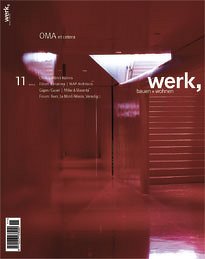Editorial
Editorial
Texts about buildings are extremely subjective, for the viewpoint of the observer determines the result even more emphatically than it does in the case of photographers. This literally means that the more exactly an author observes, understands and describes his or her impression of the building gained on the spot, the more vivid will be the image received by the mind's eye of the reader. The description of a work of architecture is only part and by no means the simplest aspect of the problem. It is the element that constitutes the foundation on which the text is based, or the narrative thread that holds the plot together and guides the reader through the building. Sometimes it acts merely as a starting or reference point for a superordinate theme that is discussed on the example of the selected building. The description is, however, invariably an essential part of texts of this kind, specifically because they are not objective, no matter how factual an impression the language may give. A good description should be both an aid to understanding and an interpretation.
Just as the author's language is characterised by his or her personal style, the interpretation is influenced by the specific experience, the knowledge, and the ability to revive associations. This ability not only ensures that a text is vivid and interesting, it also - at best - endows it with a specific gravity that is far weightier than words and sentences alone. Olof Lagercrantz once described the ability to stray here and there from the main narrative axis in order to build bridges to the past and the further as an important stylistic means of achieving the per se unfathomable quality of a good text - a statement that is valid beyond the narrow context of the novel to which it referred.
There are innumerable ways in which a text can depict the building it is describing. Questions of appropriateness, construction and rhythm play a role similar to the one they play in an architectural design. More than in other numbers of Werk,Bauen& Wohnen, this issue distinguishes - coincidentally - between the approach of the authors and their way of writing about architecture. This is another facet of the „varied selection“ to which we aspire with the et cetera issues. This extends from „classical“ architecture to journeys into one's own past; and from the phenomenological principle that is reflected in an author's text to the chain of associations that emanates from a building and spans a period of 260 million years. (The editors)
